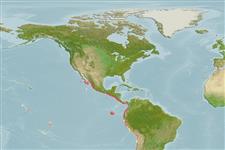Actinopterygii (ray-finned fishes) >
Scorpaeniformes (Scorpionfishes and flatheads) >
Scorpaenidae (Scorpionfishes or rockfishes) > Scorpaeninae
More on author: Garman.
Environment / Climate / Range
Ecology
Marine; bathydemersal; depth range ? - 300 m (Ref. 55763). Deep-water, preferred ?; 25°N -
Eastern Pacific: southern Baja California, Mexico to Peru.
Size / Weight / Age
Maturity: Lm ? range ? - ? cm
Max length : 27.0 cm TL male/unsexed; (Ref. 55763); common length : 15.0 cm TL male/unsexed; (Ref. 55763)
Body and head slightly compressed; body depth contained 2.9 times in standard length; eyes large, their diameter greater than snout length; inter-orbital space narrow, usually less than half eye diameter; tip of maxilla reaching posterior rim of the eye; third dorsal spine prolonged and straight; pectoral fins with 17 rays; medium sized ctenoid scales; lateral scales fewer 60; body uniformly reddish with small, irregular, brown or olive green spots on the dorsal region (Ref. 55763).
Have a thick glandular tissue on posterior margin of fin spines which is believed to be venomous (Ref. 57406).
Life cycle and mating behavior
Maturity | Reproduction | Spawning | Eggs | Fecundity | Larvae
Poss, S.G., 1995. Scorpaenidae. Rascacios, chancharros. p. 1544-1564. In W. Fischer, F. Krupp, W. Schneider, C. Sommer, K.E. Carpenter and V. Niem (eds.) Guia FAO para Identification de Especies para lo Fines de la Pesca. Pacifico Centro-Oriental. 3 Vols. FAO, Rome. (Ref. 9341)
IUCN Red List Status (Ref. 115185)
CITES (Ref. 94142)
Not Evaluated
Human uses
More information
Common namesSynonymsMetabolismPredatorsEcotoxicologyReproductionMaturitySpawningFecundityEggsEgg development
Age/SizeGrowthLength-weightLength-lengthLength-frequenciesMorphometricsMorphologyLarvaeLarval dynamicsRecruitmentAbundance
ReferencesAquacultureAquaculture profileStrainsGeneticsAllele frequenciesHeritabilityDiseasesProcessingMass conversion
Tools
Special reports
Download XML
Internet sources
Estimates of some properties based on models
Phylogenetic diversity index (Ref.
82805): PD
50 = 0.5000 [Uniqueness, from 0.5 = low to 2.0 = high].
Bayesian length-weight: a=0.01230 (0.00595 - 0.02544), b=3.02 (2.85 - 3.19), in cm Total Length, based on LWR estimates for this (Sub)family-body shape (Ref.
93245).
Trophic Level (Ref.
69278): 3.5 ±0.5 se; Based on size and trophs of closest relatives
Resilience (Ref.
69278): Medium, minimum population doubling time 1.4 - 4.4 years (Preliminary K or Fecundity.).
Vulnerability (Ref.
59153): Moderate vulnerability (42 of 100) .
